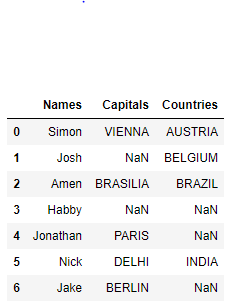Подсчитайте значения NaN в одном или нескольких столбцах в Pandas DataFrame
Let us see how to count the total number of NaN values in one or more columns in a Pandas DataFrame. In order to count the NaN values in the DataFrame, we are required to assign a dictionary to the DataFrame and that dictionary should contain numpy.nan values which is a NaN(null) value.
Consider the following DataFrame.
# importing the modulesimport numpy as npimport pandas as pd # creating the DataFramedictionary = {"Names": ["Simon", "Josh", "Amen", "Habby", "Jonathan", "Nick", "Jake"], "Capitals": ["VIENNA", np.nan, "BRASILIA", np.nan, "PARIS", "DELHI", "BERLIN"], "Countries": ["AUSTRIA", "BELGIUM", "BRAZIL", np.nan, np.nan, "INDIA", np.nan]}table = pd.DataFrame(dictionary, columns = ["Names", "Capitals", "Countries"]) # displaying the DataFramedisplay(table) |
Output :
Example 1 : Counting the NaN values in a single column.
print("Number of null values in column 1 : " + str(table.iloc[:, 1].isnull().sum()))print("Number of null values in column 2 : " + str(table.iloc[:, 2].isnull().sum())) |
Output :
Number of null values in column 1 : 2 Number of null values in column 2 : 3
Example 2 : Counting the NaN values in a single row.
print("Number of null values in row 0 : " + str(table.iloc[0, ].isnull().sum()))print("Number of null values in row 1 : " + str(table.iloc[1, ].isnull().sum()))print("Number of null values in row 3 : " + str(table.iloc[3, ].isnull().sum())) |
Output :
Number of null values in row 0 : 0 Number of null values in row 1 : 1 Number of null values in row 3 : 2
Example 3 : Counting the total NaN values in the DataFrame.
print("Total Number of null values in the DataFrame : " + str(table.isnull().sum().sum())) |
Output :
Total Number of null values in the DataFrame : 5
Example 4 : Counting the NaN values in all the columns.
display(table.isnull().sum()) |
Output :
Attention geek! Strengthen your foundations with the Python Programming Foundation Course and learn the basics.
To begin with, your interview preparations Enhance your Data Structures concepts with the Python DS Course. And to begin with your Machine Learning Journey, join the Machine Learning – Basic Level Course